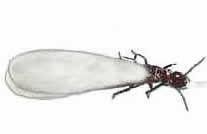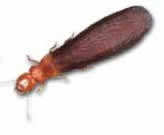
- Home Red Line
- AboutCompany
- FaqQuestions?
- TermitesLearn More
- ServicesTypes
- ProjectsPortfolio
- ContactCall Us
Subterranean Termites
Subterranean termites are considered to be the number one problem when it comes to infestation and frequent destruction on the households.
In order for survival Subterranean Termites must have a moisture source. This source is usually in the soil, giving them the name “subterranean.” The termites nests are originated in the soil but make their way to structures most often by way of mud tubes. These mud tubes are made of soil or wood that are bonded by salivary secretions. These tubes are protection for the termites against predators and also helps keep a moist environment while they search for sources of cellulose. Occasionally, aerial nests are established without mud tubes, when all the castes of the colony are present, and the necessary moisture is available from such things as condensation or leaking roofs.
Much of the damage they cause occurs in foundation and structural support wood. Because of the moisture requirements of subterranean termites, they are often found in wood that has wood rot. They usually swarm in the springtime on sunny days after rain. Subterranean termites usually enter the framing of a structure from the sub area or cracks within a concrete slab or earth filled porches. They will nest in the soil to obtain moisture, but will attack any wood, paper, fiberboard, and some fabrics that come into contact with the ground. Some signs of possible subterranean termite infestation include mud tubes, swarming and discarded wings
 |
|
Drywood Termites
The drywood termites thrive in our coastal areas. They prefer warm, moist areas. They cause more damage every year than any other natural disaster. They cause millions of dollars of damage to homes, businesses.
Their colony is inside the wood they are feeding upon. This termite even though they are called drywood termites must have moisture. They can receive the moisture through the air along the coastal areas or from a moisture source at the house. Leaking roof or pipe. This type of termite does not need ground contact for the colony. This is why they can go undetected for such a long time. They can be actively feeding inside the walls without being detected. Signs of infestation include: swarming, pellets of partly digested wood that the termite excretes, blistering on wood surfaces, and listening to the sound the wood makes when tapped.
Winged adults of western drywood termites (Incisitermes minor) are dark brown with smoky black wings and have a reddish brown head and thorax; wing veins are black. These insects are noticeably larger than subterranean termites.
 |
|
